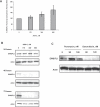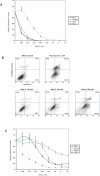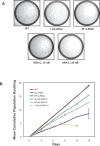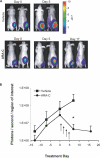Signature-based small molecule screening identifies cytosine arabinoside as an EWS/FLI modulator in Ewing sarcoma
- PMID: 17425403
- PMCID: PMC1851624
- DOI: 10.1371/journal.pmed.0040122
Signature-based small molecule screening identifies cytosine arabinoside as an EWS/FLI modulator in Ewing sarcoma
Abstract
Background: The presence of tumor-specific mutations in the cancer genome represents a potential opportunity for pharmacologic intervention to therapeutic benefit. Unfortunately, many classes of oncoproteins (e.g., transcription factors) are not amenable to conventional small-molecule screening. Despite the identification of tumor-specific somatic mutations, most cancer therapy still utilizes nonspecific, cytotoxic drugs. One illustrative example is the treatment of Ewing sarcoma. Although the EWS/FLI oncoprotein, present in the vast majority of Ewing tumors, was characterized over ten years ago, it has never been exploited as a target of therapy. Previously, this target has been intractable to modulation with traditional small-molecule library screening approaches. Here we describe a gene expression-based approach to identify compounds that induce a signature of EWS/FLI attenuation. We hypothesize that screening small-molecule libraries highly enriched for FDA-approved drugs will provide a more rapid path to clinical application.
Methods and findings: A gene expression signature for the EWS/FLI off state was determined with microarray expression profiling of Ewing sarcoma cell lines with EWS/FLI-directed RNA interference. A small-molecule library enriched for FDA-approved drugs was screened with a high-throughput, ligation-mediated amplification assay with a fluorescent, bead-based detection. Screening identified cytosine arabinoside (ARA-C) as a modulator of EWS/FLI. ARA-C reduced EWS/FLI protein abundance and accordingly diminished cell viability and transformation and abrogated tumor growth in a xenograft model. Given the poor outcomes of many patients with Ewing sarcoma and the well-established ARA-C safety profile, clinical trials testing ARA-C are warranted.
Conclusions: We demonstrate that a gene expression-based approach to small-molecule library screening can identify, for rapid clinical testing, candidate drugs that modulate previously intractable targets. Furthermore, this is a generic approach that can, in principle, be applied to the identification of modulators of any tumor-associated oncoprotein in the rare pediatric malignancies, but also in the more common adult cancers.
Conflict of interest statement
Figures






References
-
- Shapiro DN, Sublett JE, Li B, Downing JR, Naeve CW. Fusion of PAX3 to a member of the forkhead family of transcription factors in human alveolar rhabdomyosarcoma. Cancer Res. 1993;53:5108–5112. - PubMed
-
- Delattre O, Zucman J, Plougastel B, Desmaze C, Melot T, et al. Gene fusion with an ETS DNA-binding domain caused by chromosome translocation in human tumours. Nature. 1992;359:162–165. - PubMed
-
- Knezevich SR, McFadden DE, Tao W, Lim JF, Sorensen PH. A novel ETV6-NTRK3 gene fusion in congenital fibrosarcoma. Nat Genet. 1998;18:184–187. - PubMed
-
- Delattre O, Zucman J, Melot T, Garau XS, Zucker JM, et al. The Ewing family of tumors—A subgroup of small-round-cell tumors defined by specific chimeric transcripts. N Engl J Med. 1994;331:294–299. - PubMed
Publication types
MeSH terms
Substances
Grants and funding
LinkOut - more resources
Full Text Sources
Other Literature Sources
Medical
Molecular Biology Databases

